Tehran’s ‘Greater Iran’ dream a threat to the region
https://arab.news/m3bdr

In a meeting with students of Payame Noor University in Tehran last week, Mohsen Rezaee, a former Islamic Revolutionary Guard Corps (IRGC) commander and the current secretary of Iran’s Expediency Discernment Council, made some comments that deserve wider attention.
“The Western countries are concerned about Iranian science and nuclear technology, which is entering the nuclear industry and in all other industries, and is witnessing steady industrial and productive growth,” he told the students. “The fear of the West goes beyond the fear of Iran producing a nuclear bomb, because if the Greater Iran emerges north of the (Arabian) Gulf and the Sea of Oman, 15 countries will join Iran. If the Greater Iran is formed, it will interfere with global policymaking. Our duty is to bring back again the glory, greatness and might of ancient Persia, and we can carry out this task.”
This is a direct quote from the lengthy speech delivered by Rezaee. Some of those hearing or reading it believed that the speech was simply an effort by Rezaee, as a former IRGC commander, to boost the morale of university students. Others, however, were not so naive and did not downplay his statement, considering it to be further evidence of Iran’s expansionist plan, citing a host of additional evidence that carry significant weight. It should be remembered that Rezaee’s duties, in his role on the Expediency Discernment Council, include working on designing and outlining strategic plans and programs for the Iranian state.
In his 1987 book, “Sayings in Iran’s National Strategy,” which the Iranian regime has largely adopted as a guide for its foreign policy, Mohammed Javad Larijani, then a senior member and adviser on the Iranian Supreme National Security Council, laid out his “Umm Al-Qura” theory, outlining plans to create a so-called “Greater Iran.” Given this, along with subsequent regime actions and statements by senior officials, it cannot be ruled out that the expansionist plan to create a Greater Iran could be the basis of Iran’s future strategy. The most explicit indication of this at present is the imminent advent of direct military rule in Iran in the aftermath of the June 2021 presidential election and the inevitable strengthening of praetorian tendencies within the regime.
Without underestimating or exaggerating, we shall shed light on Rezaee’s comments and the likelihood of the Iranian regime implementing its ambitious expansionist plan, considering its current and future circumstances, as well as the regime’s actions and experiences over the four decades since its establishment. We shall break down Rezaee’s speech and his call to revive a Greater Iran. It is noticeable that he did not touch on the sectarian dimensions or speak of the expected Mahdi-ruled state, as the theocratic regime’s senior officials have done in the past. Instead, he emphasized Iran’s ultranationalist dimension and the desire to restore the glories of ancient imperial Iran.
Rezaee focused on the nuclear technology dimension and the boost it could give to Iran’s technological and military capabilities. As to the geographic dimension, he reiterated that Iran will be reconnected with 15 countries, including those nations with which it has maritime borders, the foremost of which, from a geopolitical perspective, is Russia. Rezaee also reiterated the importance of Iran moving toward controlling the Arabian Gulf and the Sea of Oman to realize the ultimate objective behind the Greater Iran project: Intervention in global policymaking.
These are the limits of Iran’s expansionist plan: Boosting nuclear technology, concentrating on the Arabian Gulf, expanding into neighboring countries with which it has overland and maritime borders, and interfering in global policymaking.
Are the current global conditions and circumstances conducive to the Iranian regime being able to establish its Greater Iran? It certainly seems that Iran might be able to move ahead with developing its nuclear program, as Donald Trump is set to leave office in Washington. It also seems that Iran’s economic capabilities will significantly improve if US sanctions are lifted. Despite these advantages, however, the issue of expanding into the 15 neighboring countries, as specified by Rezaee, seems to face numerous potential obstacles. For starters, Iran faces stiff competition from Turkey and Russia in its alleged areas of influence. Also, Saudi Arabia’s confrontation of the Iranian expansionist plan is likely to curb many of the regime’s ambitions.
One could also ask: Will Iran’s dependence on potential economic gains and the development of nuclear technology be sufficient for the regime to usher in its Greater Iran project? For many countries in the region, Iran has become the profoundly unwelcome living example of a state intervening in the affairs of others; infiltrating and destabilizing regional states and undermining national unity by stirring up sectarian disputes and deploying armed militias, leading to the inevitable spread of violence and a sharp deterioration in political and economic conditions.
Iran clings to the illusion that it could become a great power via deploying its militias.
Dr. Mohammed Al-Sulami
Iran clings to the illusion that it could become a great power via deploying its militias, which engage in terrorism and manage the political affairs of several countries. Given the imminent rise of Iran’s military generals to the highest position in the country’s political system, Tehran’s militias will undoubtedly receive further support and gain momentum, enabling the regime to tighten its grip on the countries that it targets. As a result, Iran aims to establish a vast militia-controlled terrorist state stretching beyond nation-state boundaries, creating total loyalty to the regime based on violence, terror and fear, rather than ideological persuasion.
On the ground, Iran has had some successes, though only in countries with a political vacuum it can exploit or whose government has been undermined by terrorism. There is no doubt, however, that this phase is temporary and must come to an end. It is difficult to run the Hezbollah model in other countries for any sustained period since people tend to gravitate toward their own real identities, transcending sectarian projects enabled by outsiders. In addition, people get tired of the constant chaos and violence enacted by militias.
In conclusion, the Greater Iran project, whose revival Rezaee has called for, will no doubt be used by the Iranian regime to justify the Iranian military class wresting control of the country’s political landscape. This will result in a sharp decline in public freedom, which is already severely limited, and living standards will further plummet due to all the country’s resources being dedicated to boosting Iran’s nuclear program and achieving the objectives of the new ruling military class.
- Dr. Mohammed Al-Sulami is Head of the International Institute for Iranian Studies (Rasanah). Twitter: @mohalsulami









































